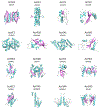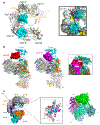Anti-CRISPRs: Protein Inhibitors of CRISPR-Cas Systems
- PMID: 32186918
- PMCID: PMC9718424
- DOI: 10.1146/annurev-biochem-011420-111224
Anti-CRISPRs: Protein Inhibitors of CRISPR-Cas Systems
Abstract
Clustered regularly interspaced short palindromic repeats (CRISPR) together with their accompanying cas (CRISPR-associated) genes are found frequently in bacteria and archaea, serving to defend against invading foreign DNA, such as viral genomes. CRISPR-Cas systems provide a uniquely powerful defense because they can adapt to newly encountered genomes. The adaptive ability of these systems has been exploited, leading to their development as highly effective tools for genome editing. The widespread use of CRISPR-Cas systems has driven a need for methods to control their activity. This review focuses on anti-CRISPRs (Acrs), proteins produced by viruses and other mobile genetic elements that can potently inhibit CRISPR-Cas systems. Discovered in 2013, there are now 54 distinct families of these proteins described, and the functional mechanisms of more than a dozen have been characterized in molecular detail. The investigation of Acrs is leading to a variety of practical applications and is providing exciting new insight into the biology of CRISPR-Cas systems.
Keywords: Acr; CRISPR-Cas; anti-CRISPR; bacteriophage; genome editing; mobile genetic element.
Figures






Similar articles
-
Type II anti-CRISPR proteins as a new tool for synthetic biology.RNA Biol. 2021 Aug;18(8):1085-1098. doi: 10.1080/15476286.2020.1827803. Epub 2020 Oct 13. RNA Biol. 2021. PMID: 32991234 Free PMC article. Review.
-
Anti-CRISPR proteins targeting the CRISPR-Cas system enrich the toolkit for genetic engineering.FEBS J. 2020 Feb;287(4):626-644. doi: 10.1111/febs.15139. Epub 2019 Nov 29. FEBS J. 2020. PMID: 31730297 Review.
-
Meet the Anti-CRISPRs: Widespread Protein Inhibitors of CRISPR-Cas Systems.CRISPR J. 2019 Feb;2(1):23-30. doi: 10.1089/crispr.2018.0052. CRISPR J. 2019. PMID: 31021234 Review.
-
Anti-CRISPR proteins: Counterattack of phages on bacterial defense (CRISPR/Cas) system.J Cell Physiol. 2018 Jan;233(1):57-59. doi: 10.1002/jcp.25877. Epub 2017 May 8. J Cell Physiol. 2018. PMID: 28247934
-
Inhibition Mechanism of an Anti-CRISPR Suppressor AcrIIA4 Targeting SpyCas9.Mol Cell. 2017 Jul 6;67(1):117-127.e5. doi: 10.1016/j.molcel.2017.05.024. Epub 2017 Jun 9. Mol Cell. 2017. PMID: 28602637 Free PMC article.
Cited by
-
Engineered Bacteriophage Therapeutics: Rationale, Challenges and Future.BioDrugs. 2021 May;35(3):255-280. doi: 10.1007/s40259-021-00480-z. Epub 2021 Apr 21. BioDrugs. 2021. PMID: 33881767 Free PMC article. Review.
-
Immunogenicity of CRISPR therapeutics-Critical considerations for clinical translation.Front Bioeng Biotechnol. 2023 Feb 16;11:1138596. doi: 10.3389/fbioe.2023.1138596. eCollection 2023. Front Bioeng Biotechnol. 2023. PMID: 36873375 Free PMC article. Review.
-
Discovery of potent and versatile CRISPR-Cas9 inhibitors engineered for chemically controllable genome editing.Nucleic Acids Res. 2022 Mar 21;50(5):2836-2853. doi: 10.1093/nar/gkac099. Nucleic Acids Res. 2022. PMID: 35188577 Free PMC article.
-
Diverse anti-defence systems are encoded in the leading region of plasmids.Nature. 2024 Nov;635(8037):186-192. doi: 10.1038/s41586-024-07994-w. Epub 2024 Oct 9. Nature. 2024. PMID: 39385022 Free PMC article.
-
AcrDB update: Predicted 3D structures of anti-CRISPRs in human gut viromes.Protein Sci. 2025 Jun;34(6):e70177. doi: 10.1002/pro.70177. Protein Sci. 2025. PMID: 40400348 Free PMC article.
References
-
- Dy RL, Richter C, Salmond GP, Fineran PC. 2014. Remarkable Mechanisms in Microbes to Resist Phage Infections. Annu Rev Virol 1: 307–31 - PubMed
-
- Amitai G, Sorek R. 2016. CRISPR-Cas adaptation: insights into the mechanism of action. Nat Rev Microbiol 14: 67–76 - PubMed
-
- Sorek R, Lawrence CM, Wiedenheft B. 2013. CRISPR-mediated adaptive immune systems in bacteria and archaea. Annu Rev Biochem 82: 237–66 - PubMed
Publication types
MeSH terms
Substances
Grants and funding
LinkOut - more resources
Full Text Sources
Other Literature Sources

